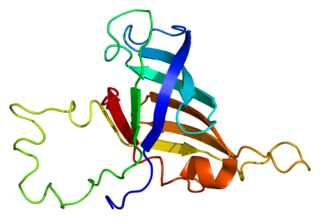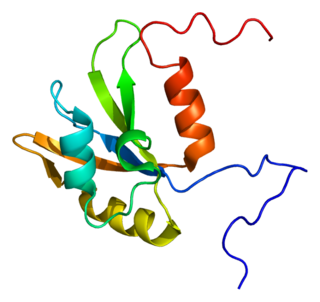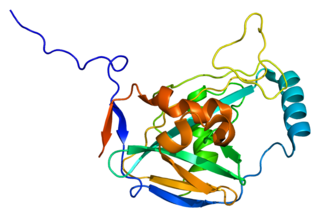Cleavage and polyadenylation specificity factor subunit 3 is a protein that in humans is encoded by the CPSF3 gene. [5] [6]
Cleavage and polyadenylation specificity factor subunit 3 is a protein that in humans is encoded by the CPSF3 gene. [5] [6]
Polyadenylation is the addition of a poly(A) tail to an RNA transcript, typically a messenger RNA (mRNA). The poly(A) tail consists of multiple adenosine monophosphates; in other words, it is a stretch of RNA that has only adenine bases. In eukaryotes, polyadenylation is part of the process that produces mature mRNA for translation. In many bacteria, the poly(A) tail promotes degradation of the mRNA. It, therefore, forms part of the larger process of gene expression.
Cleavage and polyadenylation specificity factor (CPSF) is involved in the cleavage of the 3' signaling region from a newly synthesized pre-messenger RNA (pre-mRNA) molecule in the process of gene transcription. In eukaryotes, messenger RNA precursors (pre-mRNA) are transcribed in the nucleus from DNA by the enzyme, RNA polymerase II. The pre-mRNA must undergo post-transcriptional modifications, forming mature RNA (mRNA), before they can be transported into the cytoplasm for translation into proteins. The post-transcriptional modifications are: the addition of a 5' m7G cap, splicing of intronic sequences, and 3' cleavage and polyadenylation.

DNA-directed RNA polymerases I, II, and III subunit RPABC3 is a protein that in humans is encoded by the POLR2H gene.

Heterogeneous nuclear ribonucleoprotein F is a protein that in humans is encoded by the HNRNPF gene.

Cyclin-C is a protein that in humans is encoded by the CCNC gene.

Transcription initiation factor TFIID subunit 2 is a protein that in humans is encoded by the TAF2 gene.

Cleavage stimulation factor 64 kDa subunit is a protein that in humans is encoded by the CSTF2 gene.

Cleavage and polyadenylation specificity factor subunit 5 (CPSF5) is an enzyme that in humans is encoded by the NUDT21 gene. It belongs to the Nudix family of hydrolases.

Cleavage and polyadenylation specificity factor subunit 2 is a protein that in humans is encoded by the CPSF2 gene. This protein is a subunit of the cleavage and polyadenylation specificity factor (CPSF) complex which plays a key role in pre-mRNA 3' end processing and polyadenylation. The CPSF2 protein connects the two subunits of the complex, mCF and mPSF. Its structure contributes both to the stability of the subunits interaction and to the flexibility of the complex necessary for function. This protein has been identified as an essential subunit of the complex as certain mutations in the region inhibit CPSF complex formation.

Cleavage and polyadenylation specificity factor subunit 1 is a protein that in humans is encoded by the CPSF1 gene.

Transcription initiation factor TFIID subunit 13 is a protein that in humans is encoded by the TAF13 gene.

Poly(A) polymerase alpha is an enzyme that in humans is encoded by the PAPOLA gene.

Cleavage stimulation factor 50 kDa subunit is a protein that in humans is encoded by the CSTF1 gene.

Cleavage stimulation factor 77 kDa subunit is a protein that in humans is encoded by the CSTF3 gene.

Cleavage and polyadenylation specificity factor subunit 4 is a protein that in humans is encoded by the CPSF4 gene.

Cleavage and polyadenylation specificity factor subunit 6 is a protein that in humans is encoded by the CPSF6 gene.

Integrator complex subunit 11 is a protein that in humans is encoded by the CPSF3L gene.

DNA-directed RNA polymerase III subunit RPC5 is an enzyme that in humans is encoded by the POLR3E gene.

Poly(A) polymerase gamma is an enzyme that in humans is encoded by the PAPOLG gene.

Cleavage and polyadenylation specificity factor subunit 7 is a protein that in humans is encoded by the CPSF7 gene.